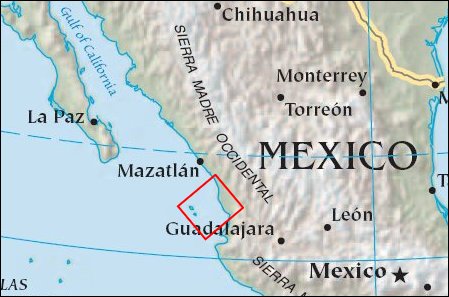| Earth from Space is a free eBook describing our planet from a satellite's perspective. Fore more information, please read the About pages. |

|

Home  North America North America  Mexico Mexico  Isla Marias Archipelago Isla Marias Archipelago |
|






|
|
Isla Marias ArchipelagoPosition of center of photo (Lat/Long): [21.416667/-106.466667] |
|
  This image, taken by an astronaut in early 2003, shows the land-sea interactions along a section of Mexicoís west coast just south of Mazatlan and the Isla Marias archipelago. The islands are a manifestation of intersecting plate boundaries - the spreading center of the East Pacific Rise, which traces south from the Gulf of California, and the subduction zone that consumes the Cocos plate beneath southern Mexico. These islands are biologically important: they comprise the Islas Marias Biosphere Reserve and contain endemic species (found nowhere else) of raccoons and rabbits. They also provide important habitat for birds and marine life. Between the islands and the mainland, swirling surface currents are highlighted by sun glinting off the ocean surface. Along the Mexican coast, water flows out from a coastal lagoon, and nearshore currents carry sediment (light-colored water) along the beach front. This image, taken by an astronaut in early 2003, shows the land-sea interactions along a section of Mexicoís west coast just south of Mazatlan and the Isla Marias archipelago. The islands are a manifestation of intersecting plate boundaries - the spreading center of the East Pacific Rise, which traces south from the Gulf of California, and the subduction zone that consumes the Cocos plate beneath southern Mexico. These islands are biologically important: they comprise the Islas Marias Biosphere Reserve and contain endemic species (found nowhere else) of raccoons and rabbits. They also provide important habitat for birds and marine life. Between the islands and the mainland, swirling surface currents are highlighted by sun glinting off the ocean surface. Along the Mexican coast, water flows out from a coastal lagoon, and nearshore currents carry sediment (light-colored water) along the beach front.
The team of oceanographers preparing to visit the East Pacific Rise is returning to a study site a few hundred miles south of Manzanillo, Mexico, where lava erupted on the sea floor in 2006, creating new oceanic crust. Hydrothermal circulation through the new crust has created warm water vents that support a community of bizarre chemosynthetic organisms. Chemosynthetic organisms get energy not from photosynthesis, but from chemicals available in the mineral-rich fluids coming from hydrothermal vents. (See the Students Experiments at Sea Website for more information on hydrothermal vents, and the mid-ocean ridge system.) The scientists will use the deep-sea exploration vehicle known as Alvin to obtain a close look at the sea floor lavas, vents, and organisms. Oceanographers who are expert geologists, chemists, and biologists are working together to understand how the new lava, circulating waters, and organisms interact and affect each other. |
| Source of material: NASA |
Further information: WikiPedia article on Isla Marias Archipelago
Last Update: 2011-03-30

